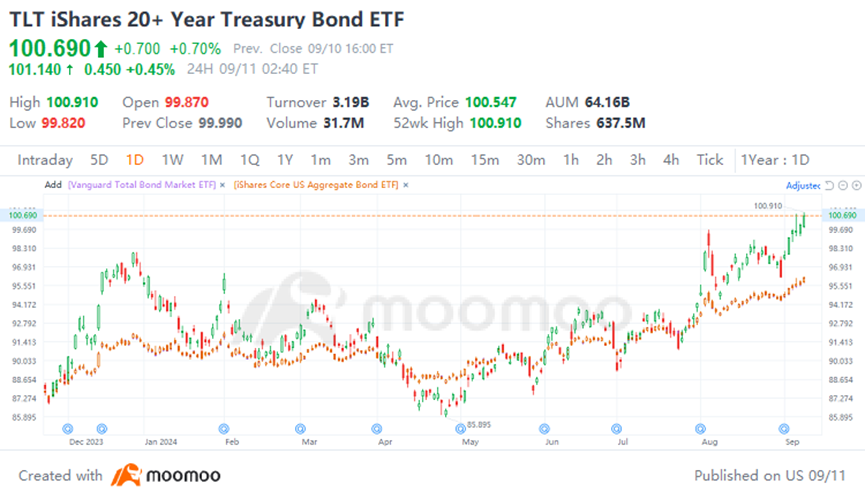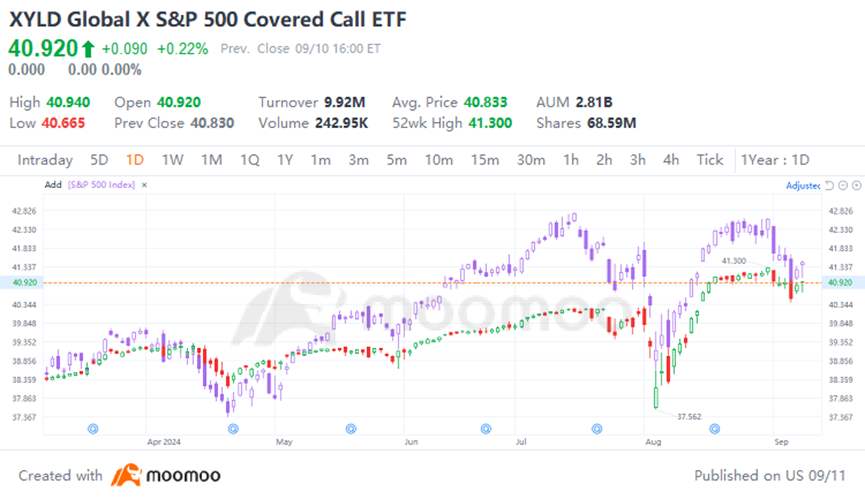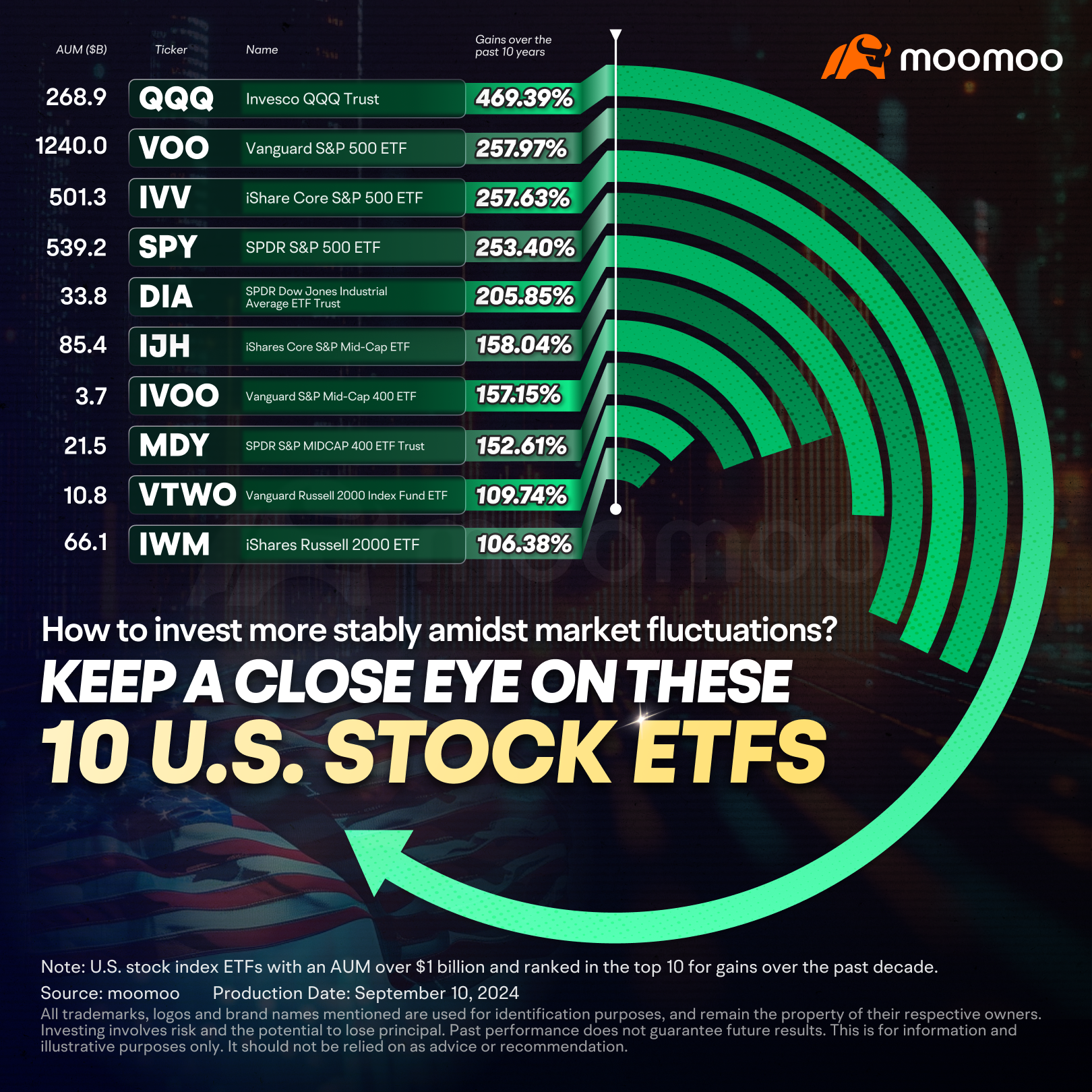Recently, market volatility has intensified due to CPI data, Federal Reserve FOMC meetings, and the upcoming U.S. presidential election, which could further increase volatility. In this context, investors looking to devise investment strategies can start with three types of ETFs: bond ETFs, options income funds, and index ETFs that are bought on dips and held over the long term.
Bond ETFs
A snapshot of ETF flows by Eric Balchunas of Bloomberg Intelligence shows bond ETFs as the only category with net inflows since the start of the month.
 The $119 billion $iShares Core US Aggregate Bond ETF (AGG.US)$ has received $1.3 billion worth of inflows so far this month. And the $116 billion $Vanguard Total Bond Market ETF (BND.US)$ has generated more than $700 million over the same period. Moreover, the bond market proxy, the $iShares 20+ Year Treasury Bond ETF (TLT.US)$, has risen 4.69% in the past five trading days and has topped $100, as the Fed Funds futures market now predicts a 100% chance of a September rate cut.
The $119 billion $iShares Core US Aggregate Bond ETF (AGG.US)$ has received $1.3 billion worth of inflows so far this month. And the $116 billion $Vanguard Total Bond Market ETF (BND.US)$ has generated more than $700 million over the same period. Moreover, the bond market proxy, the $iShares 20+ Year Treasury Bond ETF (TLT.US)$, has risen 4.69% in the past five trading days and has topped $100, as the Fed Funds futures market now predicts a 100% chance of a September rate cut.
Besides, the $Ishares Trust Core Total Usd Bd Mkt (IUSB.US)$and the $iShares 7-10 Year Treasury Bond ETF (IEF.US)$saw inflows of $2.3 billion and $1.6 billion, respectively.
“The role of bond ETFs is two-fold: to generate income and bolster returns during market declines. Additionally, bonds reminded investors of their utility as shock-absorbers, with most fixed income categories losing less ground than the broader stock market.” Barbara Friedberg, investment portfolio manager at Forbes Advisor said.
Option Income Fund
An option income funds generate current income for its investors by earning premiums from selling options contracts. This type of fund experiences smaller losses in the portfolio than the underlying asset when the market declines, but also has limited maximum profit when the market rises.
One way these funds generate income is to sell options strategies that are delta-neutral, meaning that they do not change in value as the market moves either up or down. A short straddle is an options strategy comprised of selling both a call option and a put option with the same strike price and expiration date. A covered call is another common strategy. It includes selling a call option on a stock that is currently being held in the portfolio.
$iShares 20+ Year Treasury Bond BuyWrite Strategy ETF (TLTW.US)$
The iShares 20+ Year Treasury Bond BuyWrite Strategy ETF seeks to track the the iShares 20+ Year Treasury Bond ETF while writing (selling) one-month covered call options to generate income. The fund has gained 7.14% since the beginning of the year, outperforming the TLT's increase of 4.55% over the same period.
2. $Global X S&P 500 Covered Call ETF (XYLD.US)$
The Global X S&P 500 Covered Call ETF (XYLD) buys the stocks in the S&P 500 Index and “writes” or “sells” corresponding call options on the same index. This fund's YTD performance has been less than that of the S&P 500 index, but it experienced a smaller decline than the S&P 500 during the early August selloff. The fund may perform well in times of market turbulence.
3. $Global X Nasdaq 100 Covered Call ETF (QYLD.US)$
The Global X Nasdaq 100 Covered Call ETF (QYLD) buys the stocks in the Nasdaq 100 Index and “writes” or “sells” corresponding call options on the same index. Also, During the early August selloff, the fund dropped 7.75% from its high, while the Nasdaq 100 index fell more than 11% during the same period.
Top-performing index funds
Moreover, amid the current market volatility, stable returns can still be achieved through long-term holdings of stock index ETFs.
John Bogle, the founder of Vanguard Group and the "father of index funds," once said that due to huge investment friction costs, the probability of long-term profitability is very low. Therefore, the most effective way to accumulate wealth is to keep pace with the annual return provided by the financial market, and then profit from the long-term investment portfolio. The best strategy is to invest in index funds.
$Invesco QQQ Trust (QQQ.US)$
The Invesco QQQ Trust ETF tracks the performance of the largest non-financial companies in the Nasdaq-100 Index, which includes primarily tech companies.
This ETF started trading in 1999, and it’s managed by Invesco, a fund giant. This fund is the top-performing US stock index ETF in terms of total return over the past 10 years as of September 10, 2023, with a gain of 469.39%.
2.$Vanguard S&P 500 ETF (VOO.US)$
The S&P 500 is one of the most widely-followed stock market indices in the world, and there are many funds that invest based on the index. The Vanguard S&P 500 ETF tracks the S&P 500 index and is one of the largest funds on the market. As of September 10, 2024, the fund’s AUM amounts to $1.24 trillion.
3.$iShares Core S&P 500 ETF (IVV.US)$
The iShares Core S&P 500 ETF is a fund sponsored by one of the largest fund companies, BlackRock. This iShares fund is one of the largest ETFs. As of September 10, 2024, the fund's assets under management reached $501.3 billion, with a return of 257.63% over the past 10 years.
4. $SPDR S&P 500 ETF (SPY.US)$
The SPDR S&P 500 ETF is the granddaddy of ETFs, having been founded all the way back in 1993. It helped kick off the wave of ETF investing that has become so popular today.
With assets amounting to $539.2 billion, this fund is among the most popular ETFs. It is sponsored by another heavyweight in the industry, State Street Global Advisors, and has achieved a return of 253.4% over the past 10 years.
5.$SPDR Dow Jones Industrial Average Trust (DIA.US)$
Investors don’t have a lot to choose from when it comes to ETFs tracking the Dow Jones Industrial Average, but State Street Global Advisors comes through with this fund that tracks the 30-stock index of large-cap stocks.
This fund is definitely one of the earlier ETFs, having debuted in 1998, and manages over $33.8 billion in assets. It has achieved a total return of 205.85% over the past 10 years.
6. $Vanguard Russell 2000 ETF (VTWO.US)$
The Vanguard Russell 2000 ETF tracks the Russell 2000 Index, a collection of about 2,000 of the smallest publicly traded companies in the U.S.
This ETF began trading in 2010 and currently has an asset management scale of $10.8 billion. It has achieved a total return of 106.38% over the past ten years.
Source: Yahoo Finance, Bankrate, Investopedia
最近、CPIデータ、連邦準備制度理事会のFOMC会議、および来たる米国大統領選挙により、市場のボラティリティが高まっており、ボラティリティがさらに高まる可能性があります。この文脈では、投資戦略の考案を検討している投資家は、債券ETF、オプションインカムファンド、インデックスETFの3種類のETFから始めることができます。これらはディップで購入され、長期にわたって保有されます。
債券ETF
ブルームバーグ・インテリジェンスのエリック・バルチュナスによるETFフローのスナップショットによると、月初以降、純流入があったのは債券ETFだけです。
 119億ドルは $iシェアーズ コア米国総合債券ETF (AGG.US)$ 今月これまでに13億ドル相当の資金が流入しています。そして、1160億ドルは $バンガード・米国トータル債券市場ETF (BND.US)$ 同じ期間に7億ドル以上を生み出しました。さらに、債券市場の代理人、 $iシェアーズ 米国国債 20年超 ETF (TLT.US)$は、過去5取引日で 4.69% 上昇し、100ドルを突破しました。これは、FRB先物市場が9月の利下げの可能性を100%と予測しているためです。
119億ドルは $iシェアーズ コア米国総合債券ETF (AGG.US)$ 今月これまでに13億ドル相当の資金が流入しています。そして、1160億ドルは $バンガード・米国トータル債券市場ETF (BND.US)$ 同じ期間に7億ドル以上を生み出しました。さらに、債券市場の代理人、 $iシェアーズ 米国国債 20年超 ETF (TLT.US)$は、過去5取引日で 4.69% 上昇し、100ドルを突破しました。これは、FRB先物市場が9月の利下げの可能性を100%と予測しているためです。
それに、 $Ishares Trust Core Total Usd Bd Mkt (IUSB.US)$と $iシェアーズ 米国国債 7-10年 ETF (IEF.US)$それぞれ23億ドルと16億ドルの流入が見られました。
「債券ETFの役割は2つあります。市場が下落したときに収入を生み出し、リターンを高めることです。さらに、債券は投資家にショックアブソーバーとしての有用性を思い出させました。ほとんどの債券カテゴリーは、株式市場全体よりも下落幅が小さいです。」フォーブス・アドバイザーの投資ポートフォリオ・マネージャー、バーバラ・フリードバーグ氏は言いました。
オプション収入基金
オプション・インカム・ファンドは、オプション契約の売却から保険料を稼ぐことで、投資家に現在の収入をもたらします。このタイプのファンドは、市場が下落したときのポートフォリオの損失は原資産よりも小さくなりますが、市場が上昇したときの最大利益も制限されます。
これらのファンドが収入を生み出す方法の1つは、デルタニュートラルラルのオプション戦略を売ることです。つまり、市場が上昇または下降しても価値が変化しないということです。ショートストラドルは、コールオプションとプットオプションの両方を同じ行使価格と有効期限で売ることで構成されるオプション戦略です。カバードコールも一般的な戦略です。これには、現在ポートフォリオに保有されている株式のコールオプションの売却が含まれます。
$iShares 20+ Year Treasury Bond BuyWrite Strategy ETF (TLTW.US)$
iSharesの20年以上国債の購入/書き込み戦略ETFは、iSharesの20年以上の国債ETFを追跡しながら、収益を上げるために1か月のカバードコールオプションを書く(売る)ことを目指しています。ファンドは年初から 7.14% 増加し、同時期のTLTの4.55%の増加を上回りました。
2。 $グローバルX S&P500・カバード・コール ETF (XYLD.US)$
グローバルX S&P 500カバードコールETF(XYLD)は、S&P 500インデックスの株式を購入し、同じインデックスの対応するコールオプションを「書き込み」または「売却」します。このファンドの年初来のパフォーマンスはS&P 500指数のパフォーマンスを下回っていますが、8月初旬の売却時にS&P 500よりもわずかに下落しました。ファンドは、市場が混乱しているときには好調に推移する可能性があります。
3。 $グローバルX NASDAQ100・カバード・コール ETF (QYLD.US)$
グローバルXナスダック100カバードコールETF(QYLD)は、ナスダック100インデックスの株式を購入し、同じインデックスの対応するコールオプションを「書き込み」または「売却」します。また、8月初旬の売却時には、ファンドは高値から 7.75% 下落しましたが、ナスダック100指数は同時期に 11% 以上下落しました。
最も業績の良いインデックスファンド
さらに、現在の市場のボラティリティが高い中でも、株価指数ETFを長期保有することで安定したリターンを得ることができます。
ヴァンガードグループの創設者であり、「インデックスファンドの父」であるジョン・ボーグルはかつて、投資摩擦コストが非常に大きいため、長期的な収益が見込める可能性は非常に低いと言っていました。したがって、富を蓄積する最も効果的な方法は、金融市場が提供する年間収益に遅れずについていき、長期投資ポートフォリオから利益を得ることです。最善の戦略は、インデックスファンドに投資することです。
$インベスコQQQ 信託シリーズ1 (QQQ.US)$
インベスコQQトラストETFは、主にハイテク企業を含むナスダック100指数の大手非金融企業のパフォーマンスを追跡します。
このETFは1999年に取引を開始し、ファンド大手のインベスコが管理しています。このファンドは、2023年9月10日現在、トータルリターンの面で最もパフォーマンスの高い米国株価指数ETFで、469.39%の利益を上げています。
2。$バンガード・S&P 500 ETF (VOO.US)$
S&P 500は、世界で最も広くフォローされている株式市場指数の1つで、この指数に基づいて投資するファンドはたくさんあります。バンガード・S&P500ETF はS&P 500インデックスを追跡しており、市場で最も大きなファンドの1つです。2024年9月10日現在、ファンドの運用資産額は1.24兆ドルに達しています。
3。$iシェアーズ・コア S&P 500 ETF (IVV.US)$
iShares Core S&P 500 ETFは、大手ファンド会社のひとつであるブラックロックが後援するファンドです。このiSharesファンドは、最大のETFの1つです。2024年9月10日現在、ファンドの管理資産は5,013億ドルに達し、過去10年間で257.63%の収益を上げました。
4。 $SPDR S&P 500 ETF (SPY.US)$
SPDR S&P 500 ETFは、1993年に設立された、ETFの祖父です。それは今日とても人気が高まっているETF投資の波を始めるのに役立ちました。
資産が5,392億ドルに上るこのファンドは、最も人気のあるETFの1つです。業界のもうひとつの重鎮であるステート・ストリート・グローバル・アドバイザーズが後援しており、過去10年間で253.4%の収益を達成しています。
5。$SPDR ダウ工業株平均 ETF (DIA.US)$
ダウ・ジョーンズ工業株30種平均を追跡するETFに関しては、投資家には選択肢があまりありませんが、ステート・ストリート・グローバル・アドバイザーズは、大型株の30株インデックスを追跡するこのファンドを採用しています。
このファンドは間違いなく1998年にデビューした初期のETFの1つで、338億ドル以上の資産を管理しています。過去10年間で205.85%のトータルリターンを達成しました。
6。 $バンガード・ラッセル2000 ETF (VTWO.US)$
ヴァンガード・ラッセル2000 ETFは、米国で最も小規模な上場企業約2,000社を集めたラッセル2000指数を追跡しています。
このETFは2010年に取引を開始し、現在の資産管理規模は108億ドルです。過去10年間で106.38%のトータルリターンを達成しました。
出典:ヤフーファイナンス、バンクレート、インベストペディア
 119億ドルは $iシェアーズ コア米国総合債券ETF (AGG.US)$ 今月これまでに13億ドル相当の資金が流入しています。そして、1160億ドルは $バンガード・米国トータル債券市場ETF (BND.US)$ 同じ期間に7億ドル以上を生み出しました。さらに、債券市場の代理人、 $iシェアーズ 米国国債 20年超 ETF (TLT.US)$は、過去5取引日で 4.69% 上昇し、100ドルを突破しました。これは、FRB先物市場が9月の利下げの可能性を100%と予測しているためです。
119億ドルは $iシェアーズ コア米国総合債券ETF (AGG.US)$ 今月これまでに13億ドル相当の資金が流入しています。そして、1160億ドルは $バンガード・米国トータル債券市場ETF (BND.US)$ 同じ期間に7億ドル以上を生み出しました。さらに、債券市場の代理人、 $iシェアーズ 米国国債 20年超 ETF (TLT.US)$は、過去5取引日で 4.69% 上昇し、100ドルを突破しました。これは、FRB先物市場が9月の利下げの可能性を100%と予測しているためです。




 The $119 billion
The $119 billion